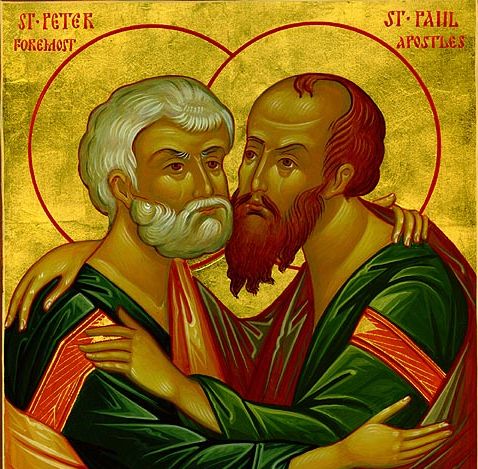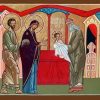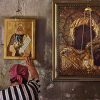Saint Peter and Saint Paul, the chiefs of the Holy Apostles, are celebrated on July 12th (June 29th) in one of the culminating feasts of the Holy Gospel, according to Saint John Maximovitch. “The Apostles Peter and Paul, without having authority over others, both stood in front of all the others on account of their warm zeal and labors. Their life was the most brilliant and was a personification of the life and labors of all the Apostles. The end of their earthly labors was especially impressive, also thanks to the fact that it occurred as it were before the eyes of the whole world. Peter was crucified upside down, and Paul was beheaded, both in Rome itself toward which at that time the gaze of all peoples was more in that they were both known personally in many places; their names were everywhere the Savior was preached. The Apostle of the Jews and the Apostle of the Gentiles (pagans) departed to Christ on the same day, as if indicating their equal nearness to God and the ONENESS of the Church of Christ, ‘where there is no Greek or Jew (Col. 3:11).’ Therefore, the day on which the earthly labors ended for the leaders of the Apostles, who labored more than all–though separated in body, yet together in spirit–became one of the most memorable days for the whole Church.
“Though it is an immovable feast, still it is bound up with the movable feasts since the preparation for it–the Apostle’s Fast–begins one week after the Feast of the Pentecost. Thus, the length of this fast also depends on the date of the celebration of the All-Holy Pascha. This day reminds us of how they went over the earth preaching the heavenly Kingdom. They emulated Christ by their poverty, endurance while being dishonored, and sufferings. They revealed their inward travails over those who heeded their preaching as well as their grief over those who paid no heed to their words. Then, finally, they offered themselves as a sacrifice. This was the earthly lot of the Apostles. But the culmination of their earthly life is at the same time the beginning of their heavenly glory…their ascent to Christ, Whom they loved, in order to remain eternally with Him. The day of their earthly end is the day of their heavenly birth. It is the receiving of the crowns of righteousness laid up for them and for all who have loved His appearing.
It is noteworthy that the Feast of the Holy Apostles follows after the Feast of the Descent of the Holy Spirit and, being in part bound up with it, the Feast of the Holy Apostles Peter and Paul culminates the yearly cycle of feasts dedicated to the earthly life of Christ and reveals the essence of His promises. Even as the Feast of the Nativity of Saint John the Baptist is the prologue to the Gospel and the beginning of the events described in it, so also the repose of the Holy Apostles Peter and Paul is both the culmination and the epilogue of the Gospel. The Feast of the Nativity of Saint John the Baptist is the beginning of the preaching of the Gospel of the New Testament on Earth; his beheading is the preaching of it in Hades; and the Feast of the Holy Apostles is the realization of it in heaven” (Saint John Maximovitch, The Feast of the Holy Apostles Peter and Paul).
We, therefore, celebrate the memory of Saints Peter and Paul with reverential awe and heartfelt love. Saint Gregory Palamas writes for the present feast: “They (Apostles) are the fathers and guides of all Christians: Apostles, Martyrs, Holy Ascetics, Priests, Hierarchs, Pastors, and Teachers. As Chief shepherds and master builders of our common godliness and virtue, they tend and teach us all, like lights in the world, ‘holding forth the word of life (Phil. 2:16).’ Their brightness excels that of the other radiantly pious and virtuous Saints as the sun outshines the stars, or as the heavens, which declare the sublime glory of God, transcend the skies…The appearance to us this day of both these luminaries together brightens the Church. It is not the case that one has a higher orbit and is placed above, while the other is lower down and passes under his shadow. Not does one rule the day, the other the night, such that one would overshadow the other if they appeared opposite each other. Light is not produced by one and received by the other in such a way that the latter’s radiance would vary sometimes depending on the distance between them. Rather, both share equally in Christ, the Everlasting Source of Eternal Light, and have attained to the same height, glory, and radiance. That is why the coming together of these lights signifies their solidarity and support for one another and illuminated the souls of the faithful twice over.”

















